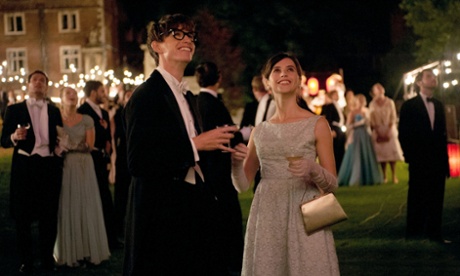
The Theory of Everything (2014)
Director: James Marsh
Entertainment grade: B+
History grade: B–
Theoretical physicist Stephen Hawking’s book A Brief History of Time: From the Big Bang to Black Holes has sold more than 10 million copies.
Romance
Jane Wilde (Felicity Jones) meets Stephen Hawking (Eddie Redmayne) at a student party. She is captivated by the clever, awkward and occasionally spiky cosmologist. “His tales made very appealing listening,” the real Jane wrote in her memoir Travelling to Infinity, “particularly because of his way of hiccoughing with laughter, almost suffocating himself, at the jokes he told, many of them against himself.” The film recreates this perfectly. Meanwhile, Hawking’s PhD supervisor, Dennis Sciama (David Thewlis), warns that his course will separate “the quarks from the quacks”. Very timely: physicist Murray Gell-Mann identified and named the quark particle in 1963, though he pronounced it to rhyme with “fork” – not, as Sciama says it in the film, to rhyme with “park”.
Illness
Jane and Stephen soon start to date, and attend a May ball together. Their relationship goes well – except that if you watch Redmayne’s exceptionally precise and quite brilliant performance closely, you will notice he gradually becomes more clumsy and less able to control his movements. Eventually, Stephen stumbles and falls in a quad – and is diagnosed with a form of motor neurone disease. The doctor tells him he has two years to live. This is a well-constructed piece of storytelling, but it isn’t quite how it happened. The real Hawking was diagnosed before he started dating Jane. Rather than pushing her away, he brushed his diagnosis off: “I mentioned how sorry I had been to hear of his stay in hospital, whereupon he wrinkled his nose and said nothing,” Jane wrote. “He behaved so convincingly as if everything were fine, and I felt it would have been cruel to have pursued the subject further.”
Physics
Some science writers have complained that Hawking’s physics has been oversimplified in the movie. It has, of course – feature films often struggle with the exposition of complex science. There are minor bloopers, such as when Hawking and his fellow PhD students attend a lecture by Sir Roger Penrose (Christian McKay) in 1963 discussing “black holes”. Astronomers first suggested that black holes might exist in the 18th century, but they were not called “black holes” until the physicist John Wheeler so named them in 1967. But the film does at least try to explain Hawking radiation, and does better than many historical films in showing that its central character was not an isolated, lone genius struggling towards discovery unaided, but actually had colleagues. Several notable physicists appear briefly as characters. It is true that Hawking and Kip Thorne (Enzo Cilenti) had a bet over whether Cygnus X-1 was a black hole. The film suggests the winner would get a year’s subscription to Penthouse. According to Jane’s memoir, Thorne wanted Penthouse – but Hawking preferred Private Eye. Astrophysics enthusiasts might note that Thorne also had a big movie out this year: he was the scientific mind behind Christopher Nolan’s Interstellar.
Relationships
Jane sticks with Stephen despite the increasing difficulties of living with him. As their relationship becomes more complex, the film becomes more interesting. Her determination that he must and will live on has an edge of zealotry, but she is gradually worn down by the toll of caring for him single-handed; he refuses to allow carers in to help. She begins a platonic romance with a hunky choirmaster, Jonathan Hellyer Jones (Charlie Cox), who effectively joins the family. Jane’s memoir Travelling to Infinity, published in 2007, was originally released as Music to Move the Stars in 1999. The earlier version was longer and painted a less forgiving picture of her former husband. Even the new edition makes him out to be a more egotistical and less saintly personality than he appears in the film, especially after he began his connection with his then-nurse, Elaine Mason (Maxine Peake).
Disharmony
In the film, the Hawkings’ marriage breakdown is civilised. In real life, Jane believed that Elaine was manipulating Stephen: “He was being persuaded that I was no longer of any use to him, that I was good for nothing … Flames of vituperation, hatred, desire for revenge leapt at me from all sides, scorching me to the quick with accusations – the unfaithful wife, the uncaring partner, the selfish career woman, work-shy and frivolous, more intent on singing than on looking after her frail, defenceless husband.” The film does not show Jane and Stephen’s decade-long estrangement, preferring to skip to their more recent reconciliation. It can be forgiven for dodging his second marriage to Elaine, from 1995-2006. Allegations that Hawking was abused during the marriage were reported, but were strongly denied by Hawking himself – making that relationship difficult territory for the film-makers to approach in any more detail than they have.
Verdict
The Theory of Everything is an accomplished and moving film, with exceptional performances. Its portrait of Stephen and Jane Hawking’s relationship is fair-minded – almost to a fault.

